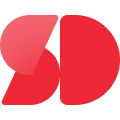Aligning Intelligent Route Planning with Marketing, Supply Chain, and Sales Operations
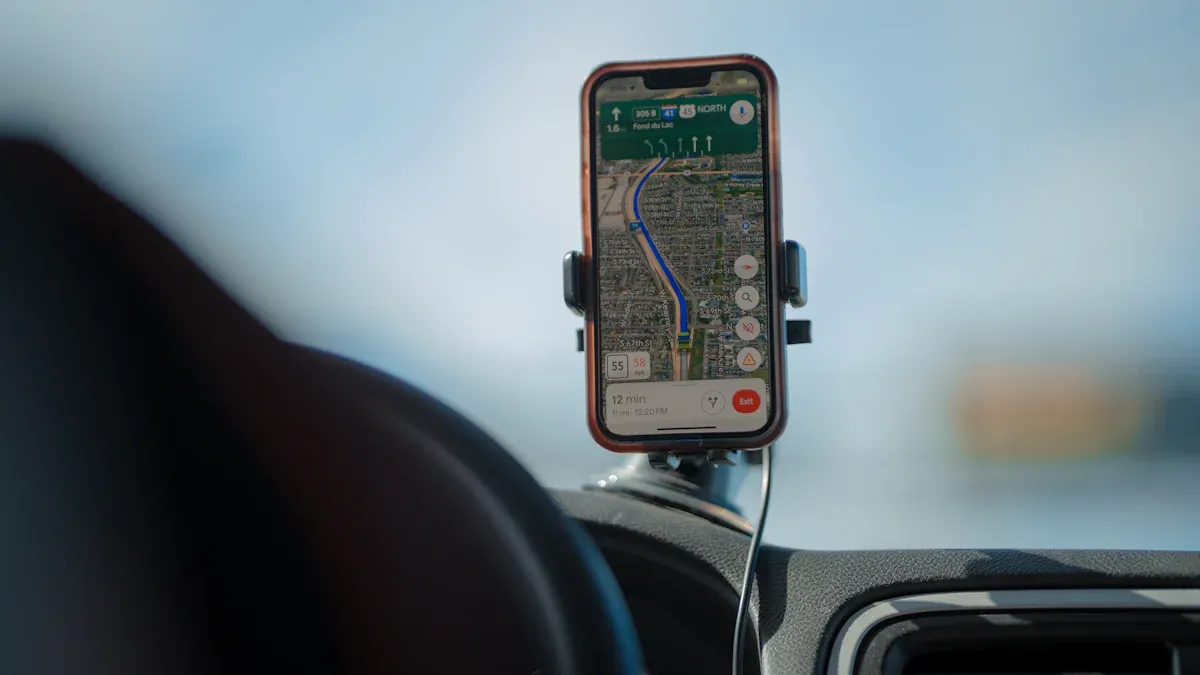
Companies today seek new ways to boost efficiency and meet customer needs. Intelligent Route Planning stands out as a powerful solution. Recent industry data highlights its impact:
Efficiency Metric | Quantitative Evidence |
|---|---|
Inventory Levels Reduction | |
Logistics Costs Reduction | 35% significant reduction; 45% some reduction |
Delivery Time Improvement | 25% significantly faster; 60% somewhat faster |
AI-driven tools help teams lower costs, speed up deliveries, and manage inventory better. Seamless integration of these systems supports smarter decisions and stronger business results.
Key Takeaways
Intelligent Route Planning uses AI and real-time data to create efficient delivery routes, cutting costs and speeding up deliveries.
Aligning marketing, supply chain, and sales teams improves communication, boosts revenue, and enhances customer satisfaction.
Breaking down silos between departments prevents costly mistakes and helps companies respond faster to market changes.
Integrating route planning with business functions leads to better resource use, lower expenses, and stronger teamwork.
Using clear goals, shared data, and automation tools supports continuous improvement and long-term business growth.
Intelligent Route Planning: Definition and Business Value
What is Intelligent Route Planning
Intelligent Route Planning refers to the use of advanced technologies, such as artificial intelligence (AI) and machine learning, to optimize transportation routes. It involves analyzing real-time data, historical patterns, and predictive models to determine the most efficient paths for delivery or travel. This approach minimizes delays, reduces costs, and enhances overall operational efficiency.
Several companies have successfully implemented Intelligent Route Planning systems to achieve remarkable results:
Company | Case Study Highlights | Core Concepts Illustrated |
|---|---|---|
Amazon | Improved delivery accuracy by 30% using machine learning algorithms; real-time route adjustments based on traffic and demand. | Use of AI and real-time data integration for dynamic routing. |
UPS | Implemented ORION system to optimize routes, saving millions of gallons of fuel and reducing carbon emissions. | Algorithmic route calculation and fuel-efficient routing. |
FedEx | Uses proprietary software analyzing delivery data and traffic to dynamically adjust routes, reducing fuel costs. | Real-time data integration and sustainability focus. |
Coca-Cola | Reduced miles driven and operational costs by analyzing delivery routes and customer demand. | Multi-stop optimization and cost reduction. |
PepsiCo | Integrated route optimization tools with existing systems to reduce transportation costs and improve efficiency. | Software integration and delivery pattern analysis. |
Home Depot | Reduced delivery times and improved customer satisfaction by using advanced routing software with real-time traffic data. | Real-time adjustments and customer service enhancement. |
These examples illustrate the definition and core concepts of Intelligent Route Planning, showcasing its ability to leverage AI, dynamic routing, and data integration for tangible business benefits.
Key Components and Capabilities
Intelligent Route Planning systems rely on several key components to deliver optimal results:
Real-Time Data Integration: Systems analyze live traffic conditions, weather forecasts, and delivery schedules to adjust routes dynamically.
Predictive Analytics: Historical data and machine learning algorithms forecast potential delays and suggest alternative routes.
Algorithmic Optimization: Techniques like ant colony optimization and particle swarm optimization enhance route efficiency and reduce costs.
Automation Tools: Automated workflows streamline decision-making and reduce human errors.
Quantitative analyses validate these capabilities. For instance, predictive analytics leveraging traffic patterns and weather data enable continuous improvement. Algorithms applied to tourism route planning in Chinese cities have demonstrated measurable improvements in travel time and cost reduction. Additionally, real-time traffic data streams from Dublin city sensors showcase how dynamic traffic prediction enhances route planning in congested urban environments.
Business Benefits and Impact
The implementation of Intelligent Route Planning delivers significant business value:
Operational Efficiency: Companies report up to threefold improvements in efficiency and fivefold reductions in operational costs.
Cost Savings: Fuel-efficient routing and optimized delivery schedules reduce transportation expenses.
Enhanced Decision-Making: AI-driven alerts and automation improve accuracy and productivity.
Customer Satisfaction: Faster deliveries and real-time adjustments enhance the customer experience.
Statistical measures further validate these benefits. Metrics such as on-time delivery rates, ROI, and user satisfaction rates highlight the positive impact of Intelligent Route Planning on business outcomes. Continuous KPI tracking ensures sustained success and drives ongoing optimization efforts.
The Importance of Alignment Across Business Functions
Why Alignment Drives Business Success
Alignment across marketing, supply chain, and sales operations creates a strong foundation for business growth. When teams work together, they share information, set common goals, and use the same tools. This unity leads to better results and faster progress.
Companies with aligned sales, marketing, and supply chain functions see up to 208% more revenue from marketing efforts.
Customer retention rates rise by 36% when sales and marketing teams work closely.
Sales win rates increase by about 38% with strong alignment.
Aligned organizations achieve 19% faster revenue growth and 27% faster profit growth.
Customer acquisition costs drop by 30% in well-aligned companies.
Businesses with strong alignment report 67% greater effectiveness in closing deals and 58% better customer retention.
Aligned companies grow at an average annual rate of 20%, while poorly aligned firms often see declines.
These trends show that alignment helps companies grow faster, keep more customers, and use resources more efficiently. Teams that share technology and processes also respond better to market changes. They can launch new products quickly and solve problems before they become serious. Alignment supports a culture of teamwork, where everyone works toward the same goals.
Tip: Regular meetings and shared dashboards help teams stay aligned and focused on results.
Risks and Costs of Siloed Operations
Siloed operations create barriers between departments. These barriers slow down communication, cause mistakes, and waste resources. Real-world examples show how costly silos can be for companies.
The Boeing 737 MAX crisis happened because engineering and commercial teams did not share critical safety information. This lack of communication led to two fatal crashes and over $20 billion in direct costs. Citibank lost $500 million due to a payment error caused by fragmented processes. Kodak missed the digital camera revolution because its divisions did not work together, leading to bankruptcy and a collapse in shareholder value.
Research shows that siloed organizations lose 15% of workforce capacity to redundant activities. Innovation cycles take 30-40% longer, and customer experience suffers. Companies with silos see a 45% drop in customer retention and a 25% decrease in repeat purchase value.
Employees in siloed environments are 3.5 times more likely to leave within two years, costing millions in replacement expenses.
Job satisfaction drops by 37% and productivity falls by 29% in siloed teams.
Departments with poor collaboration have 42% higher error rates and 67% more customer issues.
Siloed companies respond 2.7 times slower to market changes, losing market share and revenue.
Senior leaders spend 43% of their time resolving conflicts caused by silos, leading to lost executive focus.
Siloed companies have 15-20% lower success rates on new initiatives and waste millions on duplicated efforts.
Deloitte’s research highlights that traditional cost-cutting in silos often misses hidden inefficiencies. A food company found that fragmented cost management led to errors across finance, sales, and customer service. By moving to a cross-functional model, the company uncovered hidden costs and achieved savings and new revenue opportunities.
Note: Breaking down silos allows companies to find hidden savings, improve teamwork, and drive long-term growth.
Intelligent Route Planning in Marketing Integration
Synchronizing Marketing Campaigns with Route Planning
Marketing teams often plan promotions and product launches that depend on timely deliveries. Intelligent Route Planning helps marketing and logistics teams work together. When a company launches a new product, the marketing team can share campaign schedules with the route planning team. This allows delivery routes to match campaign timelines. As a result, stores receive products on time, and customers see promotions as planned. Teams can use shared dashboards to track campaign progress and delivery status. This approach reduces confusion and helps everyone stay on the same page.
Addressing Marketing Challenges Through Integration
Many marketing challenges come from late deliveries, high costs, or poor resource use. By integrating route planning with marketing, companies can solve these problems. The following table shows how key metrics improve when teams work together:
Metric | Benchmark / Target | Impact on Marketing Challenges |
|---|---|---|
Delivery Time Variance | < 10% deviation | Improves customer satisfaction and retention by up to 20% |
On-Time Delivery Rate | > 95% (target 98%) | Raises customer satisfaction and retention rates |
Cost per Delivery | $135 - $180 | Supports competitive pricing strategies |
Route Optimization Efficiency | Up to 15% reduction in travel time | Reduces costs and improves delivery reliability |
Driver Productivity | Enhanced by 25% | Increases timely deliveries by 18% |
Companies that use these metrics see smoother operations and fewer missed deliveries. Route optimization also lowers fuel and labor costs. These savings help companies offer better prices and keep customers happy.
Enhancing Customer Engagement and Campaign ROI
When marketing and route planning teams align, customers notice faster and more reliable deliveries. Real-time tracking lets customers follow their orders, which builds trust. Companies can use delivery data to adjust campaigns and target the right audience. For example, if a campaign leads to high demand in one area, teams can quickly adjust routes to meet that demand. This flexibility increases campaign return on investment (ROI) and keeps customers engaged.
Companies that connect marketing with Intelligent Route Planning see higher customer satisfaction and stronger brand loyalty.
Intelligent Route Planning for Supply Chain Optimization
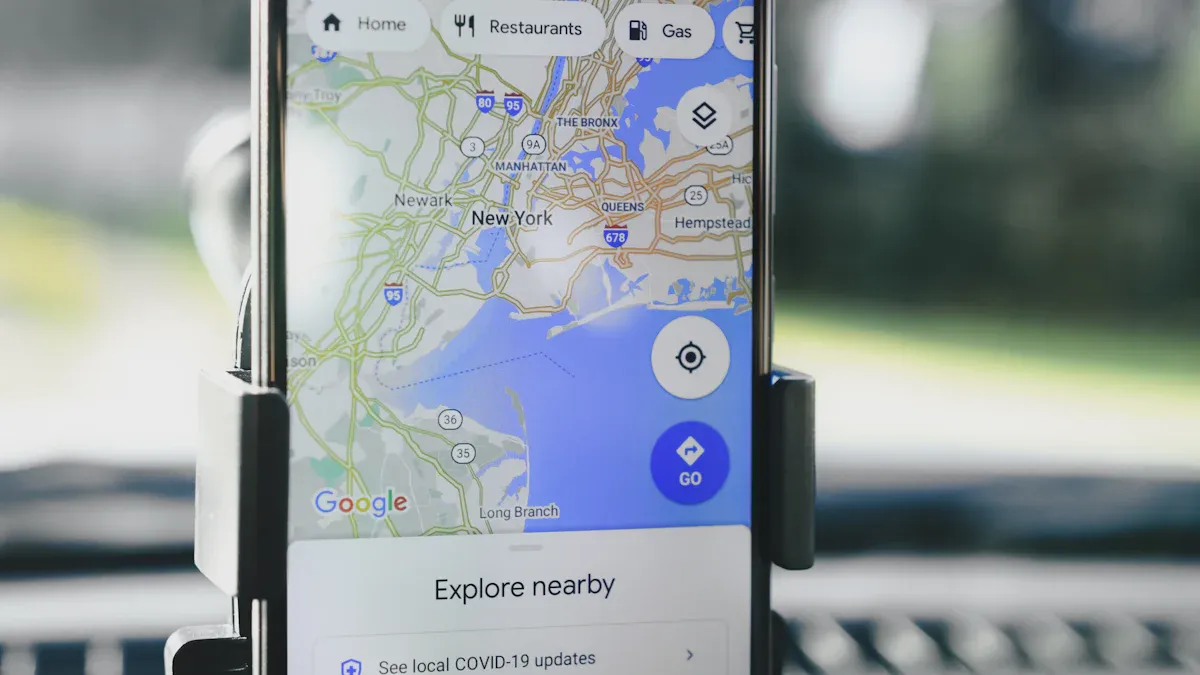
Supply Chain Objectives and Pain Points
Supply chain leaders aim to deliver products on time, reduce costs, and meet sustainability goals. Many face challenges that slow progress and increase expenses. Common pain points include:
Too much manual work in dispatching and route planning
Inconsistent on-time delivery rates due to driver differences
Rising costs from fuel, maintenance, and re-deliveries
Missed sustainability targets from inefficient routing and idling vehicles
Last-mile delivery costs can reach up to 53% of total shipping expenses. Empty miles—when trucks travel without cargo—waste resources. In the U.S., 15% of freight vehicle miles are empty. The EU sees 21.2%, and the UK faces 30%. These inefficiencies add up to billions of wasted miles each year.
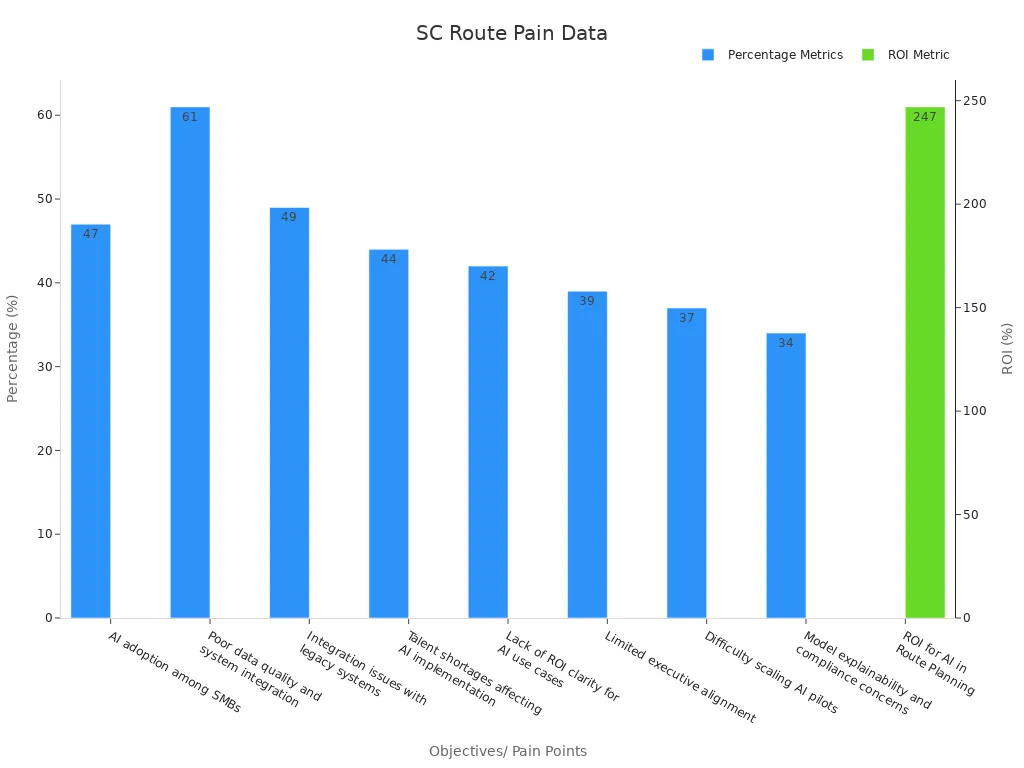
A table below highlights key objectives and barriers:
Supply Chain Objective / Pain Point | Statistic / ROI Value | Source / Context |
|---|---|---|
AI adoption among SMBs | Supply Chain Dive 2025 SMB Tech Survey | |
ROI for AI in Route Planning | 247% ROI | High-leverage AI use case |
Poor data quality and system integration | 61% of supply chain leaders | BCG AI in SC Report, 2025 |
Integration issues with legacy systems | 49% of companies | Deloitte Tech Gap Study, 2025 |
Optimizing Logistics, Inventory, and Delivery
Companies use predictive analytics and AI-driven route planning to improve logistics. These systems gather real-time data from IoT devices, traffic feeds, and fleet status. Algorithms solve complex routing problems, considering road closures, driver shifts, and delivery windows. This approach reduces fuel use, improves estimated arrival times, and lowers delivery failures.
A table below shows important performance metrics:
Metric Name | Definition | Why It Matters | Action Plan Highlights |
|---|---|---|---|
Sales per Route | Average sales generated per delivery route | Shows how well routes generate sales and spots inefficiencies. | Monitor route sales; focus on high-sales areas; adjust product mix and inventory. |
Fleet Capacity Utilization | Percentage of fleet capacity used | Measures how well the fleet is used; low values show routing or vehicle allocation issues. | Track usage; optimize packaging; reallocate vehicles; use dynamic routing software. |
On-Time Delivery Rate | Percentage of deliveries made within promised timeframe | Key for customer satisfaction and efficiency; low rates risk unhappy customers. | Monitor times; fix bottlenecks; use real-time tracking and communication. |
Route optimization software analyzes traffic, delivery windows, and vehicle capacity to create efficient routes. Real-time adjustments help drivers avoid traffic jams or schedule changes. Predictive analytics forecast disruptions, allowing teams to plan ahead. These improvements lead to better planning and higher on-time delivery rates.
Improving Responsiveness and Reducing Costs
Companies use route optimization software to find the most cost-effective delivery routes. They consolidate shipments to lower transportation expenses and select carriers based on cost and reliability. Key performance indicators include inventory turnover rate, order fulfillment rates, and transportation cost per unit.
Route optimization reduces mileage and fuel use, cutting transportation costs.
Shipment consolidation improves vehicle capacity use, lowering per-unit costs.
Monitoring KPIs like transportation cost per unit and order accuracy helps teams improve over time.
Enhanced route planning leads to faster turnaround and fewer delays, making the supply chain more responsive.
Proactive route planning helps companies respond quickly to changes, reduce costs, and keep customers satisfied.
Intelligent Route Planning in Sales Operations
Aligning Sales Strategies with Route Optimization
Sales strategies become more effective when aligned with route optimization. Intelligent Route Planning enables sales teams to prioritize high-value clients and allocate resources efficiently. By analyzing customer demographics, historical sales data, and market trends, businesses can optimize sales territories. This ensures that sales representatives focus on areas with the highest potential, avoiding duplicate visits and wasted efforts.
Predictive analytics further enhance this alignment by forecasting demand and identifying prospects likely to convert. For example, AI-driven tools streamline workflows, allowing sales teams to concentrate on building relationships and closing deals. Real-time tracking also empowers managers to monitor sales metrics and adjust strategies dynamically, ensuring continuous improvement.
Enhancing Field Sales Efficiency and Customer Experience
Optimized routes significantly improve field sales efficiency and customer satisfaction. Sales representatives can visit more clients daily due to reduced travel time. This not only increases productivity but also allows more time for meaningful customer interactions. Companies like PepsiCo have demonstrated a 30% boost in route efficiency, enabling sales teams to engage customers more effectively and drive higher sales.
Key performance metrics highlight these improvements:
Reduced average distance traveled and fuel usage.
Lower travel costs and time spent per visit.
Higher conversion rates by route or region.
These metrics help managers refine route strategies, leading to better customer experiences. On-time visits foster trust and loyalty, while accurate delivery estimates reduce delays, enhancing satisfaction.
Leveraging Data for Sales Performance
Data analytics play a pivotal role in improving overall sales performance. Intelligent Route Planning reduces travel inefficiencies, ensuring on-time meetings and minimizing costs. GPS tracking integrated with route planning further enhances operational efficiency by eliminating unnecessary miles.
Sales analytics optimize territory allocation by analyzing market trends and customer data. Automation tools streamline processes like lead management, enabling sales teams to focus on high-value activities. Predictive analytics identify high-value prospects, helping businesses prioritize efforts and improve conversion rates. These data-driven insights empower managers to make informed decisions, coach teams effectively, and achieve better results.
Cross-Functional Collaboration and Unified Planning
Building Effective Communication Channels
Effective communication forms the backbone of unified planning. Teams need clear channels to share updates, track progress, and resolve issues quickly. Companies use tools like collaborative platforms, Gantt charts, and regular check-ins to keep everyone informed. These tools help teams avoid confusion and ensure that everyone understands their roles.
The table below highlights common challenges and the solutions that improve communication:
Challenge | Solution/Metric | Validation of Communication Effectiveness |
|---|---|---|
Lack of Accountability | Clear goal ownership, regular check-ins | Roles and responsibilities are tracked |
Conflicting Goals | Align goals with company vision | Unified objectives, less miscommunication |
Information Silos | Transparent channels, knowledge sharing | Open information flow, better collaboration |
Lack of Shared Metrics | Unified measurement frameworks (OKRs, KPIs) | Common indicators for cross-functional success |
Remote/Hybrid Communication | Virtual team building, clear protocols, collaboration tools | Bridges gaps caused by distance |
Regular status updates and shared dashboards help teams stay aligned. These practices build trust and keep projects on track.
Data Sharing and Integrated Planning Processes
Data sharing allows teams to make better decisions together. Studies show that models like the supply and demand model and the SECI model help organizations integrate across functions. System theory and synergy theory highlight the importance of working together and sharing resources.
Trust and commitment between teams support smooth integration.
Clear cooperation rules and shared goals guide unified planning.
Big data, AI, and cloud platforms help break down silos and improve resource use.
Simulation studies show that integrated strategies reduce risks and boost efficiency.
When teams share data and use integrated planning, they work more efficiently and respond faster to changes.
Overcoming Organizational Barriers
Organizational barriers can slow down unified planning. Successful companies use several strategies to overcome these challenges:
Improve communication so all voices are heard.
Clarify roles and responsibilities early.
Identify and leverage key influencers within teams.
Align everyone around common goals to break down silos.
Leaders communicate a clear vision and listen to feedback.
Delegate tasks to skilled team members.
Address resistance to change by involving employees early and offering support.
Reframe change as an opportunity and highlight new benefits.
Cross-functional collaboration and T-shaped skills help teams work together and achieve better results. Open communication and trust unify efforts across departments, making the organization stronger.
Enabling Technologies for Intelligent Route Planning Alignment
AI and Machine Learning Applications
AI and machine learning power the core of modern route planning systems. These technologies analyze large amounts of data to predict traffic, weather, and demand. Companies use AI to find the best routes by considering many factors at once. Machine learning models learn from past deliveries and improve over time. They help teams avoid traffic jams, reduce delays, and save fuel. AI also helps forecast demand, so companies can plan routes before problems happen. This leads to fewer missed deliveries and happier customers.
Real-Time Analytics and Data Integration
Real-time analytics and data integration bring together information from many sources. Systems collect live traffic updates, weather reports, and vehicle data. This information helps teams adjust routes quickly when conditions change. Mobile apps give drivers and dispatchers up-to-date route details. Predictive analytics spot patterns in traffic and demand, so teams can plan ahead. These tools make route planning more flexible and accurate.
Aspect | Traditional Route Optimization | Data-Driven Route Optimization |
|---|---|---|
Basis | Primarily distance or time-based | Multiple data sources: real-time traffic, weather, vehicle data, predictive analytics |
Flexibility | Static, manual changes | Dynamic, real-time adjustments |
Efficiency | Improved over manual routing | Maximizes efficiency by considering many variables |
Customer Satisfaction | Improved punctuality | Highly accurate ETAs and real-time updates enhance satisfaction |
Real-time data integration reduces costs, improves efficiency, and boosts customer satisfaction by providing accurate delivery times and quick responses to disruptions.
Automation and Workflow Optimization Tools
Automation tools streamline route planning and daily operations. These systems handle repetitive tasks, such as assigning drivers or updating delivery schedules. Automated workflows reduce mistakes and speed up decision-making. Companies see lower fuel use, fewer maintenance issues, and better use of vehicles and drivers. Route clustering and zone-based deliveries cut down on travel distance and wasted miles. Automation also improves on-time delivery rates and customer satisfaction by sending real-time updates and accurate ETAs.
Lower operational costs and higher ROI
Increased employee productivity and better resource use
Enhanced customer experience with faster, more reliable service
Automation frees staff to focus on important work, while customers enjoy faster deliveries and better communication.
Real-World Examples of Intelligent Route Planning Alignment

Success Stories from Leading Organizations
Many leading organizations have achieved measurable improvements by aligning their operations with Intelligent Route Planning. UPS reduced delivery times by 10% and cut transportation costs by 5%. FedEx increased vehicle utilization by 15% and lowered fuel consumption by 10%. The company also achieved a 20% reduction in fuel consumption since 2010, avoiding over 10 million metric tons of CO2 emissions. Amazon halved its order processing time and improved customer satisfaction by 20%. Transportation companies using Transport Management Systems (TMS) have seen up to a 15% reduction in operating costs.
Organization | Improvement Metric | Statistical Evidence |
|---|---|---|
UPS | Delivery time reduction | 10% reduction in delivery time |
UPS | Transportation cost reduction | 5% decrease in transportation costs |
FedEx | Vehicle utilization | 15% increase in vehicle utilization |
FedEx | Fuel consumption | 10% reduction in fuel consumption |
FedEx | Environmental impact (ESG) | 20% reduction in fuel consumption since 2010; avoided over 10 million metric tons of CO2 emissions |
Amazon | Order processing time | 50% reduction in order processing time |
Amazon | Customer satisfaction | 20% improvement in customer satisfaction |
Transportation Company (general) | Operating cost reduction | Up to 15% reduction in operating costs using TMS services |
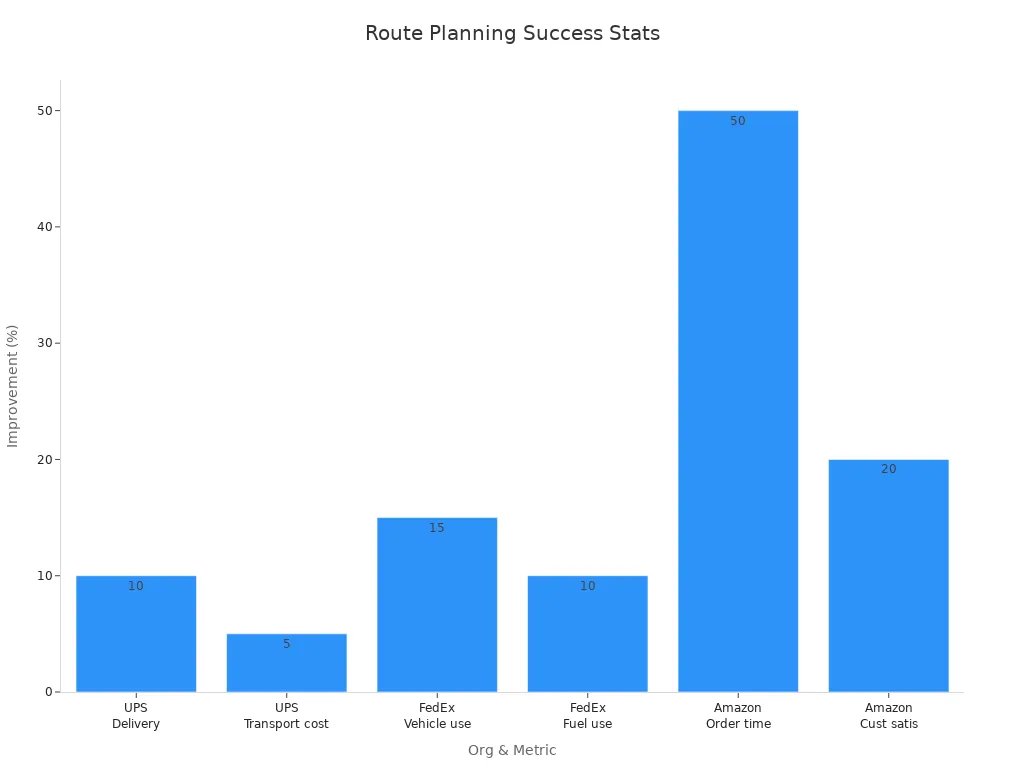
These results show that companies can achieve faster deliveries, lower costs, and better sustainability by integrating route planning with other business functions.
Key Lessons and Best Practices
Organizations that succeed with Intelligent Route Planning use structured frameworks to guide their efforts. Outcome Mapping helps teams track progress with clear markers and strategy maps. This approach links activities, outcomes, and goals, making it easier to adjust plans and measure results. Teams keep journals to monitor performance and challenges, which supports continuous improvement.
Strategic planning frameworks recommend setting SMART goals—specific, measurable, attainable, responsible, and time-bound. Companies select key performance indicators (KPIs) to track progress. They cascade these goals down to departments and teams, ensuring everyone works toward the same objectives.
The OKR (Objectives and Key Results) framework also supports alignment. Teams set clear objectives and measure key results. Regular reviews and updates keep everyone focused and allow for quick adjustments. Ownership and transparency play a big role in success.
An outcomes-based instructional design framework connects training to business results. Teams define what success looks like and use data to check if they meet their goals. This method ensures that training and adoption efforts lead to real improvements in performance.
Teams that use these best practices see better alignment, clearer goals, and measurable progress across their organizations.
Overcoming Implementation Challenges
Common Obstacles to Alignment
Many organizations face significant challenges when aligning intelligent route planning with marketing, supply chain, and sales operations. Departments often set conflicting key performance indicators (KPIs). For example, supply chain teams may focus on reducing inventory, while sales teams want to increase stock to meet customer demand. This misalignment leads to confusion and inefficiency.
A lack of a dedicated Sales and Operations Planning (S&OP) process owner can slow decision-making. Without clear leadership, teams struggle to coordinate efforts. Manual planning remains a problem in many companies. Teams often rely on spreadsheets or outdated tools, which increases overtime and reduces the accuracy of long-term plans.
Poor communication between departments creates further obstacles. In one case, a commerce team overestimated demand because they did not consult procurement, client service, or retail partners. This mistake led to overstock and financial losses. Cross-functional collaboration remains essential, yet many organizations fail to involve key account managers or client service teams in risk evaluation during planning meetings.
Note: Misalignment and poor communication can cause costly errors and missed opportunities.
Solutions and Change Management Approaches
Organizations can overcome these challenges by adopting structured solutions and effective change management strategies.
Establish Clear Ownership: Assign a dedicated S&OP process owner. This leader coordinates efforts and ensures accountability.
Align KPIs Across Departments: Set shared goals for marketing, supply chain, and sales. Unified KPIs help teams work toward the same objectives.
Automate Planning Processes: Invest in intelligent route planning tools. Automation reduces manual work and improves accuracy.
Foster Cross-Functional Collaboration: Involve client service and key account managers in planning and risk evaluation. Regular meetings and shared dashboards improve transparency.
Enhance Communication: Create open channels for feedback and updates. Encourage teams to share information early and often.
A table below summarizes these approaches:
Challenge | Solution |
|---|---|
Unified performance metrics | |
Lack of ownership | Dedicated process leader |
Manual planning | Automation and smart tools |
Poor communication | Regular cross-team meetings |
By following these steps, organizations can build a culture of alignment and continuous improvement.
Actionable Steps for Effective Alignment
Building a Roadmap for Integration
A clear roadmap guides organizations through the integration of intelligent route planning with business operations. Leaders start by assessing current systems and identifying gaps in technology and processes. They then set specific goals that align with company strategy, such as improving delivery times or reducing costs. Stakeholder involvement ensures that the roadmap reflects real business needs and priorities.
Successful companies, like Airbnb, use a three-stage approach. They begin with survival mode, focusing on cost control. Next, they stabilize by adapting to new trends and adding features. Finally, they move to growth mode, expanding offerings and supporting partners. Netflix also builds its roadmap through brainstorming and prioritizing features that delight customers and improve margins.
Key steps in an effective roadmap include:
Assess current systems and workflows.
Set clear KPIs and integration goals.
Select the right technology and consolidate data sources.
Pilot new processes and train staff.
Scale up deployment and monitor progress.
Organizations benefit from using digital tools, such as AI and simulation software, to support planning and decision-making. These tools help teams manage risks, optimize costs, and adapt to regulatory or geographic challenges. Roadmapping brings better efficiency, visibility, and control across logistics, inventory, and distribution.
Measuring Success and Driving Continuous Improvement
Continuous improvement relies on tracking the right performance indicators. Companies select a balanced set of KPIs that reflect value for customers, employees, and the business. They use both leading indicators, which predict future trends, and lagging indicators, which show past results.
Important metrics include:
Time reductions in delivery or planning processes.
Safety improvements, like fewer workplace incidents.
ROI, measuring financial gains from investments.
Quality metrics, such as order accuracy and on-time shipments.
Teams set SMART goals for each KPI and review them regularly using real-time dashboards. Automated data collection enables quick adjustments and keeps everyone accountable. This structured approach ensures that organizations can adapt, optimize, and sustain improvements in route planning and business alignment.
Tip: Frequent reviews and transparent reporting help teams stay focused and drive ongoing success.
Aligning intelligent route planning with marketing, supply chain, and sales operations creates measurable business value. AI and cloud-based platforms now automate data gathering, improve forecast accuracy, and optimize supply planning. These tools help companies adapt quickly to market changes and reduce costs. The S&OP process, enhanced by technology, supports continuous improvement and stronger teamwork.
Benefit Area | Measurable Impact |
|---|---|
Growth Target Achievement | |
Forecast Accuracy | 20-40% higher |
Operational Efficiency | 20-30% increase |
Planning Time | Up to 50% faster |
Cross-functional integration leads to better efficiency, higher customer satisfaction, and greater profitability. Companies that prioritize alignment set the stage for long-term growth.
FAQ
What is the main advantage of aligning intelligent route planning with business functions?
Aligning intelligent route planning with marketing, supply chain, and sales operations increases efficiency. Teams share data and goals. This approach reduces costs, improves delivery times, and boosts customer satisfaction.
How does intelligent route planning improve customer experience?
Intelligent route planning ensures faster and more reliable deliveries. Customers receive accurate updates and on-time shipments. This reliability builds trust and encourages repeat business.
Can small businesses benefit from intelligent route planning?
Small businesses gain significant value from intelligent route planning. They optimize routes, lower fuel costs, and improve service quality. These improvements help them compete with larger companies.
What technologies support intelligent route planning?
AI, machine learning, real-time analytics, and automation tools support intelligent route planning. These technologies analyze data, predict demand, and adjust routes quickly.
How can companies measure the success of route planning integration?
Companies track key performance indicators (KPIs) such as delivery times, cost savings, and customer satisfaction. Regular reviews and real-time dashboards help teams monitor progress and drive improvement.
See Also
Multi-Tiered Design For AI-Driven Global Supply Networks
The Journey From Automation To Intelligent Supply Chains
Top Four Algorithms Powering Large-Scale Daily Restocking
Creating A Centralized Data Hub For S&OP Success
Understanding Key Algorithms Driving Efficient Delivery Routes
